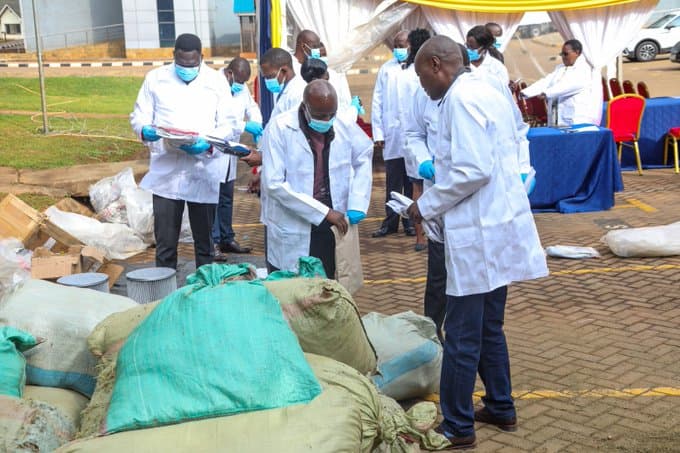We're loading the full news article for you. This includes the article content, images, author information, and related articles.
A historic narcotics bust by the Kenya Navy exposes the nation's escalating role as both a trafficking superhighway and a consumption market, forcing a strategic overhaul of its security and public health response.

A record seizure of 1,024 kilograms of methamphetamine valued at Sh8.2 billion from a vessel in the Indian Ocean has cast a harsh spotlight on the scale and sophistication of transnational drug trafficking networks operating along the East African coast. The operation, which took place on Thursday, October 23, 2025, has prompted an immediate call from security agencies for enhanced surveillance and a deeper, multi-faceted strategy to combat the growing narcotics threat to Kenya and the region.
The stateless dhow, identified by authorities as MV Ighol, was intercepted approximately 630 kilometres east of Mombasa by the Kenya Navy Ship (KNS) SHUPAVU following intelligence from regional and international partners. According to the Directorate of Criminal Investigations (DCI), the operation, codenamed 'Bahari Safi 2025.01', led to the arrest of six Iranian nationals. Interior Cabinet Secretary Kipchumba Murkomen confirmed on Sunday, October 26, 2025, that the seized substance was 98% pure methamphetamine and announced the government's intention to publicly destroy the consignment as a statement against trafficking.
This interception is one of the largest drug busts in Kenya's history and underscores the country's critical position in the global narcotics trade. For years, Kenya has been identified by international bodies, including the U.S. State Department, as a significant transit point for heroin from Southwest Asia and cocaine from South America, destined for markets in Europe and North America. Traffickers have long exploited the country's extensive coastline and corruption within key institutions to move their illicit cargo.
While the transit threat remains, a more alarming trend has emerged: Kenya is rapidly becoming a major consumption hub. At the 32nd Meeting of Heads of National Drug Law Enforcement Agencies (HONLEA) in Vienna on October 8, 2025, Dr. Anthony Omerikwa, CEO of the National Authority for the Campaign Against Alcohol and Drug Abuse (NACADA), warned of a “steady shift from traditional substances to synthetic drugs” that are “causing havoc among young people.” The recent methamphetamine seizure validates these concerns, with NACADA confirming that the substance has been detected in urban establishments, including shisha dens.
The domestic impact is stark. A NACADA report from February 2025 revealed that 53% of Kenyans have used a drug in their lifetime. A separate survey of university students, also from February 2025, found alarming usage rates, with 1 in 59 students having used heroin and 1 in 63 having used cocaine. This growing local demand provides a lucrative secondary market for traffickers, complicating law enforcement efforts and fueling a public health crisis.
Despite successes like the recent seizure, Kenya's fight against narcotics is hampered by deep-seated challenges. A study by the University of Nairobi highlighted that the police Anti-Narcotics Unit is often constrained by limited financing, outdated equipment, and insufficient personnel. Furthermore, corruption remains a primary enabler of the drug trade, with traffickers known to have links to political and law enforcement circles, according to a report by ENACT, an organized crime observatory.
The judicial system also presents a significant bottleneck. An August 2024 analysis by the Institute for Security Studies noted that massive court backlogs and procedural loopholes allow high-level traffickers to evade prosecution for years, often while out on bail, undermining public trust in the justice system.
In response, Kenyan authorities are adopting a broader, more integrated approach. The successful interception of the MV Ighol was a result of a multi-agency effort involving the DCI, Kenya Navy, Kenya Coast Guard Service, and international cooperation under the Safe Seas Africa (SSA) Programme. This model of intelligence-led, collaborative enforcement is being prioritized to dismantle trafficking networks.
Beyond enforcement, NACADA is spearheading a shift towards a public health-focused strategy. This includes the recent launch of a National Drug Observatory to monitor emerging trends in real-time and a policy push for Alternatives to Incarceration, which diverts people who use drugs towards treatment and rehabilitation rather than prison. At the regional level, the East African Community (EAC) continues to call for strengthened cross-border cooperation to tackle transnational organized crime, including narcotics trafficking.
The Sh8.2 billion seizure is a tactical victory, but it serves as a sobering reminder of the strategic threat Kenya faces. Combating the dual challenge of sophisticated international trafficking and a growing domestic addiction crisis will require sustained political will, robust institutional capacity, and unwavering regional and international partnership.
Keep the conversation in one place—threads here stay linked to the story and in the forums.
Other hot threads
E-sports and Gaming Community in Kenya
Active 6 months ago
Popular Recreational Activities Across Counties
Active 6 months ago
The Role of Technology in Modern Agriculture (AgriTech)
Active 6 months ago
Investing in Youth Sports Development Programs
Active 6 months ago